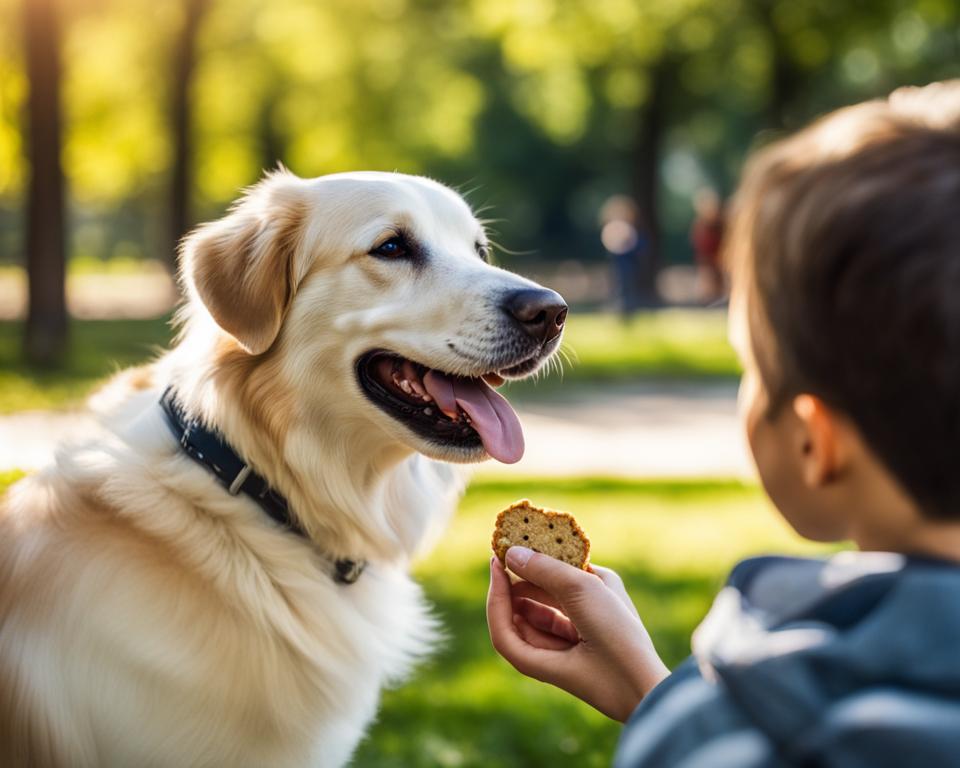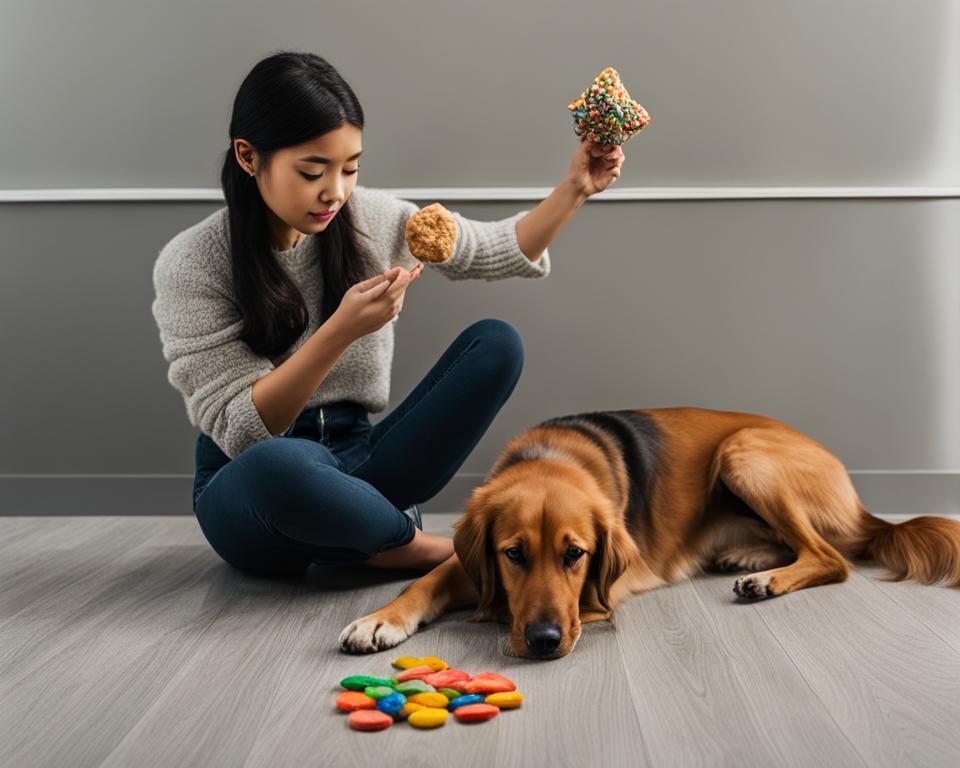Training your pet can be a challenging and rewarding experience. The key to successful pet training lies in mastering the art of patience. Patience is crucial for building trust and confidence in your pet, overcoming training frustration, and celebrating small achievements. By embracing patience, you can create a positive training experience for both you and your pet.
Key Takeaways:
- Mastering the art of patience is essential for successful pet training.
- Patience helps build trust and confidence in your pet.
- Overcoming training frustration is possible by remaining patient.
- Celebrating small achievements keeps both you and your pet motivated.
- Embracing patience creates a positive training experience for you and your pet.
Embracing Patience for Effective Pet Training
Pet training requires a patient and understanding approach to achieve effective results. Patience serves as the foundation for building trust and confidence between you and your pet. By demonstrating patience during training sessions, you create a safe and supportive environment that encourages your pet to learn and grow.
The Foundation of Trust and Confidence in Training
Trust and confidence are essential elements in pet training. When your pet feels safe and trusts you, they are more likely to respond positively to the training process. Patience allows you to establish a strong foundation of trust and confidence, enabling you to guide your pet through various training exercises without causing them undue stress or anxiety.
“Trust is earned when actions meet words.”
– Chris Butler
By consistently showing patience in training, you can build a bond with your pet based on trust, which enables effective communication and understanding.
Strategies for Overcoming Training Frustration
Training can sometimes be frustrating, but patience is the key to overcoming these challenges. When faced with obstacles or difficulties during training sessions, it is important to remain calm and composed. Take breaks when needed, regroup, and approach the training from a fresh perspective.
Experimenting with different techniques and methods can also help overcome training frustration. Each pet is unique, and what works for one may not work for another. By remaining patient and adaptable, you can find alternative approaches that resonate with your pet and facilitate the learning process.
Highlighting the Successes: Celebrating Small Achievements
Celebrating small achievements is an important aspect of effective pet training. Setting realistic goals and acknowledging your pet’s progress along the way can keep both of you motivated and engaged in the training process. Small victories, such as successfully following a command or learning a new trick, should be acknowledged and celebrated.
Remember, pet training is a journey that requires time and effort. By embracing patience and celebrating the small accomplishments, you can foster a positive training experience for your pet and forge a deeper connection with them.
Training Your Pet for Success: The Ultimate Guide
When it comes to training your pet, having a comprehensive guide is essential for achieving success. In this section, I will provide you with the ultimate pet training guide that covers all the crucial aspects of pet training. By following this guide, you can establish a solid foundation for your pet’s training journey and set them up for long-term success.
Before diving into the specific training techniques, it’s important to understand that each pet is unique and may require a customized approach. Some pets may respond better to certain methods, while others may have different learning needs. By taking the time to understand your pet’s individuality, you can tailor your training methods to their specific requirements, ensuring a more effective training experience.

Now, let’s explore the different aspects of pet training that will be covered in this ultimate guide:
Obedience Commands
Teaching your pet obedience commands is essential for their safety and well-being. We will discuss how to train your pet to follow basic commands such as “sit,” “stay,” “come,” and more. By establishing clear and consistent commands, you can ensure better control and communication with your pet.
Behavior Modification
Addressing unwanted behaviors is another crucial aspect of pet training. We will delve into effective behavior modification techniques that can help you tackle issues such as excessive barking, jumping, chewing, and aggression. By understanding the underlying causes of these behaviors and implementing appropriate training methods, you can guide your pet towards more desirable behaviors.
House Training
House training is one of the first priorities when bringing a new pet into your home. We will provide you with a step-by-step guide on how to successfully potty train your pet and prevent accidents in the house. By establishing a consistent routine and using positive reinforcement, you can ensure a clean and hygienic environment for both you and your pet.
Within this ultimate pet training guide, you will find detailed instructions, practical tips, and real-life examples to help you navigate the training process smoothly. Remember, training your pet requires patience, consistency, and positive reinforcement. By investing time and effort into their training, you can create a harmonious relationship built on trust and understanding.
Understanding Your Pet’s Individual Learning Needs
When it comes to pet training, recognizing that every pet has unique learning needs is essential for achieving successful results. Just as humans have different ways of processing information and acquiring skills, our furry friends also possess individual learning styles and preferences.
To optimize your pet’s learning potential, it’s crucial to understand their specific learning needs and tailor your training approach accordingly. By doing so, you can create a personalized training program that caters to your pet’s strengths and challenges, leading to improved training outcomes and a stronger bond between you and your pet.
One way to gain insight into your pet’s individual learning needs is by observing their behavior patterns. Take note of how they respond to different training techniques and stimuli. Some pets may be more motivated by treats, while others may respond better to praise and affection. By understanding these preferences, you can adapt your training methods and provide the most effective rewards and incentives for your pet.
Additionally, consider the specific learning style of your pet. Some pets are visual learners, meaning they respond well to demonstrations and visual cues. Others may be more auditory learners, being more receptive to verbal commands and tone of voice. By identifying your pet’s learning style, you can incorporate suitable training techniques that align with their preferred mode of learning.
Incorporating different training approaches that cater to your pet’s learning needs can also enhance their engagement and motivation during training sessions. By keeping the training sessions stimulating and enjoyable, you’ll be able to hold your pet’s attention for longer periods, allowing them to absorb and understand the training concepts more effectively.
To summarize, understanding your pet’s individual learning needs is crucial for personalized pet training. By recognizing their unique learning styles, behavior patterns, and preferences, you can tailor your training approach to optimize their learning potential. This customization will not only lead to better training outcomes but also deepen the bond between you and your pet.
Timing: The Critical Element in Reward-Based Training
Timing plays a crucial role in reward-based pet training. The well-timed delivery of rewards is essential for reinforcing desired behaviors effectively. By understanding and implementing the science of operant conditioning, pet owners can optimize their training techniques for better results.
The Science of Operant Conditioning and Its Applications
Operant conditioning is a fundamental principle in pet training. It involves using rewards and punishments to shape and modify behavior. The timing of these reinforcements is crucial in operant conditioning. When a reward is given immediately after a desired behavior, it strengthens the association between the behavior and the reward, making the behavior more likely to reoccur in the future.
For example, when teaching a dog to sit on command, providing a treat as soon as the dog sits reinforces the behavior and encourages them to repeat it in anticipation of the reward. This process forms the basis of reward-based training.
In addition to treats, rewards can also include praise, playtime, or any other positive reinforcement that motivates your pet. The key is to ensure that the reward is delivered promptly and directly connected to the desired behavior.
Well-timed Rewards: Tips and Techniques
To ensure optimal timing in reward-based training, consider the following tips and techniques:
- Use a marker signal: A marker signal, such as a clicker or a specific word like “yes,” can be used to immediately indicate to your pet that they have performed the desired behavior correctly. This allows for precise timing of the reward, as the marker signal serves as a bridge between the behavior and the reinforcement.
- Be consistent: Consistency is key when timing rewards. Deliver rewards consistently, immediately after the desired behavior, to reinforce the association effectively.
- Be aware of latency: Avoid delays between the desired behavior and the reward, as this can lead to confusion and weaken the reinforcement. Aim for minimal latency to ensure clear communication.
- Practice timing: Training professionals recommend practicing timing with simple behaviors before moving on to more complex tasks. This helps refine your timing skills and ensures consistency in reward delivery.
Common Timing Mistakes to Avoid
While timing rewards is essential, there are common timing mistakes that pet owners should be aware of and avoid:
- Delayed rewards: Delaying rewards can cause confusion and weaken the association between the behavior and the reinforcement. Remember to provide rewards promptly after the desired behavior.
- Incorrect timing of marker signals: If using a marker signal, such as a clicker, make sure to use it precisely at the moment the desired behavior occurs. Inaccurate timing can cause confusion and hinder the learning process.
- Inconsistent timing: Inconsistency in the timing of rewards can result in mixed signals for your pet. Aim for consistency to reinforce the desired behaviors effectively.
By understanding the critical role of timing in reward-based training, pet owners can enhance their training techniques and improve the effectiveness of their pet’s learning process. Well-timed rewards, combined with the science of operant conditioning, create a positive training experience and foster a strong bond between you and your pet.

Mastering Dog Training Techniques
There are various techniques that can be employed to achieve successful dog training. From developing consistency in obedience commands to exploring advanced training concepts, mastering dog training techniques is essential for effective and efficient training. In this section, we will delve into the importance of developing consistency in obedience commands and explore advanced training concepts that can take your canine’s training to the next level.
Developing Consistency in Obedience Commands
Consistency is key when it comes to obedience training for dogs. By ensuring that your dog understands and follows your instructions reliably, you can establish clear communication and build a strong foundation for their training. Consistency allows your dog to learn and respond to your commands consistently, leading to better obedience and overall behavior. To develop consistency, it is important to use clear and concise commands, reinforce positive behaviors consistently, and establish a predictable routine in your training sessions.
Advanced Training Concepts for Your Canine
Once you have mastered the basics of obedience training, you can explore advanced training concepts to challenge and stimulate your dog further. Advanced training concepts can include teaching tricks, participating in agility training, or engaging in specialized activities that cater to your dog’s unique abilities and interests. These advanced training techniques not only provide mental and physical stimulation for your canine companion but also strengthen the bond between you and your dog.
Cat Training Strategies: Engaging Your Feline’s Mind
Training cats can be a unique challenge, but it is entirely possible with the right strategies. By understanding the nature of cats and their natural instincts, you can effectively train them and foster a stronger bond. Engaging your feline’s mind is key to successful cat training, as it provides mental stimulation and helps prevent behavior issues. From litter box training to leash training, here are some effective cat training strategies to consider:
- Litter Box Training: Start by placing the litter box in a quiet and easily accessible area. Show your cat where it is and praise them when they use it. Clean the litter regularly to ensure cleanliness and encourage consistent use.
- Leash Training: Gradually introduce your cat to a harness and leash indoors. Use positive reinforcement, such as treats and praise, to reward them for wearing the harness. Start with short walks around the house and gradually progress to outdoor exploration.
- Clicker Training: Clicker training is a useful technique for teaching cats new behaviors. Use a clicker to mark the desired behavior, followed by a reward. With consistent practice, your cat will learn to associate the click sound with positive reinforcement.
- Interactive Toys: Engage your cat’s mind with interactive toys that stimulate their natural hunting instincts. Toys that dispense treats or require problem-solving skills can provide mental stimulation and prevent boredom.
- Scratching Post Training: Provide a designated scratching post and reward your cat for using it. Place the post in areas where your cat tends to scratch and use positive reinforcement to encourage them to use it instead of furniture or carpets.
Remember, patience and consistency are key when training your cat. It’s important to understand that cats have their own unique personalities and learning styles. Be sure to tailor your training methods to suit your cat’s individual needs and always use positive reinforcement to create a positive and rewarding training experience. By engaging your feline’s mind and utilizing their natural instincts, you can successfully train your cat and strengthen the bond between you and your beloved pet.
Positive Reinforcement Training: Encouraging Good Behavior
Positive reinforcement training is a powerful method for encouraging good behavior in pets. By utilizing this approach, you can create a nurturing environment that promotes learning and desirable behaviors. This section will delve into the principles of positive reinforcement and provide insights into effectively using rewards to reinforce desired behaviors in your pet.
Positive reinforcement training is based on the simple concept of rewarding your pet for exhibiting the behaviors you want to encourage. Rather than focusing on punishment or correction, positive reinforcement training centers around providing positive experiences and rewards for good behavior.
This training technique helps to establish a strong bond between you and your pet, as it creates a positive association with learning and following commands. With positive reinforcement, your pet will be motivated to repeat behaviors that lead to rewards, leading to consistent and lasting good behavior.
When implementing positive reinforcement training, it’s essential to identify the specific behaviors you want to encourage in your pet. Clearly define these behaviors and establish consistent cues or commands to signal when you expect them to be performed.
For example: If you are training your dog to sit, you can use a verbal command, such as “Sit,” along with a hand gesture. Consistency is key in reinforcing this behavior.
Once you have determined the behaviors you want to reinforce, it’s important to select appropriate rewards. Rewards can include treats, praise, playtime, or any other positive experience that your pet finds rewarding.
A crucial aspect of positive reinforcement training is timing. Rewards must be given immediately after the desired behavior occurs to ensure a clear association between the behavior and the reward. This prompt reinforcement strengthens the connection, making it more likely that your pet will repeat the behavior in the future.
Note: It’s important to use rewards that are meaningful to your pet. Understand what motivates your pet and tailor the rewards accordingly.

Positive reinforcement training not only encourages good behavior but also helps to build a strong and trusting relationship between you and your pet. It creates a positive and enjoyable training experience, promoting your pet’s self-confidence and willingness to learn.
In the next section, we will explore behavior training for pets beyond the basics, addressing advanced techniques for modifying challenging behaviors and creating a harmonious home environment.
Behavior Training for Pets: Beyond the Basics
Behavior training is an essential aspect of pet ownership, going beyond basic obedience commands to address specific behavioral issues. By focusing on advanced behavior training techniques, you can help your pet overcome challenges such as separation anxiety, aggression, and destructive behaviors, creating a harmonious home environment.
One effective technique in behavior modification is desensitization, which involves gradually exposing your pet to the triggers that cause unwanted behavior. For example, if your dog becomes anxious when left alone, you can gradually increase the duration of separation to help them become more comfortable being alone. Patience and consistency are key in desensitization training, as it takes time for your pet to change their behavior.

Another important aspect of behavior training is using positive reinforcement techniques. By rewarding your pet for desired behaviors, you can encourage them to repeat those behaviors in the future. Positive reinforcement can be in the form of treats, praise, or playtime, depending on what motivates your pet. This approach helps create a positive association with the desired behavior, making it more likely to be repeated.
It’s important to remember that behavior training is a continuous process that requires patience, consistency, and understanding. Each pet is unique, and what works for one may not work for another. It’s essential to tailor your training techniques to your pet’s individual needs and personality.
By delving into advanced behavior training techniques and addressing specific behavioral issues, you can help your pet overcome challenges and improve their overall conduct and well-being. With patience and dedication, you can create a positive and well-behaved pet that brings joy and harmony to your home.
Obedience Training for Pets: Establishing Command Relationships
Obedience training is a crucial aspect of pet ownership that focuses on establishing strong command relationships between you and your pet. It is essential for creating a harmonious and well-behaved pet who responds to your commands reliably. By implementing effective obedience training techniques, you can establish yourself as the leader and guide your pet towards proper behavior and obedience.
Clear communication is key in obedience training. Consistent expectations and a firm yet gentle approach help your pet understand the desired behaviors and the consequences of not following commands. This clear guidance builds trust and respect between you and your pet, strengthening the command relationship.
There are various pet training techniques available for obedience training. These techniques include positive reinforcement, clicker training, leash training, and more. It is important to choose the techniques that work best for you and your pet, taking into consideration their individual needs, temperament, and learning style.
“Training a pet requires patience, consistency, and the willingness to invest time and effort. By establishing strong command relationships through obedience training, you can shape your pet’s behavior while fostering a deep bond based on trust and respect.”
Obedience training not only teaches your pet to follow basic commands such as sit, stay, and come but also provides mental stimulation and reinforces discipline. It helps prevent behavioral problems such as excessive barking, aggression, or destructive habits by redirecting their energy towards positive behaviors.
Establishing command relationships through obedience training is not limited to dogs alone. Cats, birds, and other pets can also benefit from obedience training, albeit with slight modifications to suit their natural instincts and behaviors.
By investing time and effort into obedience training, you are setting a solid foundation for a well-behaved and responsive pet. This training helps create a positive environment where both you and your pet can enjoy a fulfilling and balanced relationship.
Conclusion
As I conclude this article on pet training, it is essential to recap the key takeaways that will help you become a successful pet trainer. First and foremost, patience is the most valuable virtue when it comes to training your pet. It builds trust and confidence, enables you to overcome training frustration, and allows you to celebrate the small achievements that form the foundation of successful training.
Another crucial aspect is understanding your pet’s individual learning needs. Each pet is unique and requires personalized training approaches. By recognizing their behavior patterns and adapting your training methods accordingly, you can optimize their learning potential and achieve better results.
Utilizing effective training techniques, particularly positive reinforcement, is highly beneficial. Reward-based training encourages good behavior and creates a nurturing environment for your pet to thrive. It focuses on reinforcing desired behaviors through well-timed rewards, motivating them to learn and exhibit positive conduct.
In conclusion, by embracing patience, understanding your pet’s individual learning needs, and utilizing effective training techniques, you can master the art of pet training. Investing time and effort into training your pet will not only develop their obedience and behavior but also strengthen the bond between you and your beloved companion. So, remember to be patient, adaptable, and positive as you embark on this training journey with your pet.
FAQ
Why is patience important in pet training?
Patience is crucial in building trust and confidence between you and your pet, overcoming training frustration, and celebrating small achievements.
How can I overcome training frustration?
Strategies for overcoming training frustration include taking breaks, revisiting the basics, breaking down tasks into smaller steps, and seeking help from a professional trainer if needed.
Why is it important to celebrate small achievements during pet training?
Celebrating small achievements helps keep both you and your pet motivated and engaged in the training process. It also reinforces positive behavior and builds confidence.
What does the ultimate guide to pet training cover?
The ultimate guide to pet training covers various aspects of training, including obedience commands, behavior modification, and house training, to set your pet up for long-term success.
How can I understand my pet’s individual learning needs?
Understanding your pet’s individual learning needs involves observing their behavior, taking note of their preferences and responses, and adapting your training approach accordingly.
How does timing affect reward-based training?
Timing is critical in reward-based training because it ensures that rewards are delivered immediately after desired behaviors, reinforcing them effectively and increasing the chances of your pet repeating those behaviors.
What are some common timing mistakes to avoid in pet training?
Common timing mistakes include delayed rewards, inconsistent timing, and accidentally rewarding undesired behaviors. These mistakes can hinder the learning process and affect the success of the training.
What advanced training concepts can I explore for my dog?
Advanced training concepts for dogs include teaching them tricks, agility training, and other mentally stimulating activities that can enhance their training and overall well-being.
How can I train my cat using effective strategies?
Effective cat training strategies involve engaging your feline’s mind and utilizing their natural instincts. These can include litter box training, leash training, and other techniques specific to cats.
What is positive reinforcement training, and how does it encourage good behavior?
Positive reinforcement training is a method that encourages good behavior by rewarding desired actions. By focusing on positive reinforcement, you can create a nurturing environment that encourages your pet to learn and exhibit good behavior.
How can behavior training help my pet beyond basic obedience commands?
Behavior training goes beyond basic obedience commands and addresses issues such as separation anxiety, aggression, and destructive behaviors. It helps improve your pet’s overall conduct and well-being.
What is the importance of obedience training for pets?
Obedience training is essential for establishing command relationships between you and your pet. It focuses on clear communication and consistent expectations, leading to a well-behaved and responsive pet.
Source Links
- https://dogtrainingblogger.com/dog-training-patience-and-timing/
- https://www.pamdennison.com/product/you-can-train-your-dog-mastering-the-art-science-of-modern-dog-training/
- https://pettable.com/training

